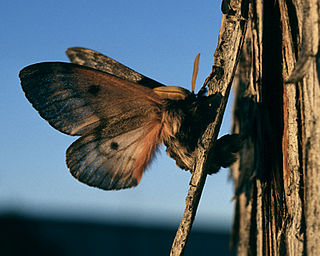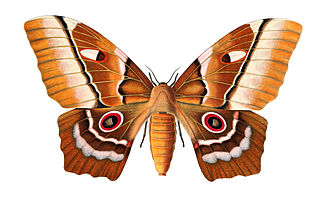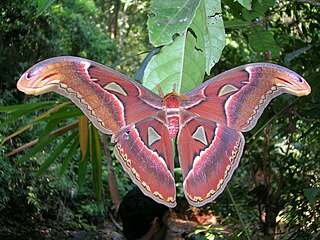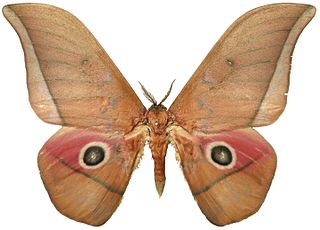
Saturniidae, commonly known as saturniids, is a family of Lepidoptera with an estimated 2,300 described species. The family contains some of the largest species of moths in the world. Notable members include the emperor moths, royal moths, and giant silk moths.

Coloradia is a genus of moths of the family Saturniidae. There are nine described species found in Mexico and eastern North America. The genus was first described by C. A. Blake in 1863.

Eacles is a genus of moths in the family Saturniidae. They are native to the Americas. The genus was erected by Jacob Hübner in 1819.

The dryandra moth is a species of moth that is considered to be the sole member of the family Carthaeidae. Its closest relatives are the Saturniidae and it bears a resemblance to many species of that family, bearing prominent eyespots on all wings. The common name is derived from the Dryandra shrubs of the genus Banksia, on which the larva of this species feed, and is hence restricted to the south-west of Western Australia where these shrubs grow. Other Grevillea shrubs may also be used as host plants.

Actias sinensis, the Golden moon moth, is a moth of the Family Saturniidae. It is found in China, Taiwan, Vietnam, Myanmar, India and Thailand. The species was first described by Francis Walker in 1855.

Caligula is a genus of moths of the family Saturniidae. It is primarily an Oriental genus, found in India, China and Southeast Asia. The genus is often treated as a synonym of Rinaca. It is named after Roman emperor Caligula.

The Saturniinae or saturniines are a subfamily of the family Saturniidae. They are commonly known as emperor moths or wild silk moths. They are easily spotted by the eyespots on the upper surface of their wings. Some exhibit realistic eye-like markings, whilst others have adapted the eyespots to form crescent moon or angular shapes or have lost their wing scales to create transparent windows. They are medium to very large moths, with adult wingspans ranging from 7.5 to 15 cm, in some cases even more. They consist of some of the largest groups of Lepidoptera like the moon or luna moth, atlas moth, and many more. The Saturniinae is an important source of wild silk and human food in many different cultures.

Pseudimbrasia is a monotypic moth genus in the family Saturniidae described by Pierre Claude Rougeot in 1962. Its only species, Pseudimbrasia deyrollei, described by James Thomson in 1858, is found in the mid-latitudes of Africa.

Attacus is a genus of moths in the family Saturniidae. The genus was erected by Carl Linnaeus in his 1767 12th edition of Systema Naturae.

Automeris is a genus of moths in the family Saturniidae and the subfamily Hemileucinae. As of 1996 there were 124 species, and more have since been described. These moths are generally characterized by the eyelike patches on the hindwings and the leaflike pattern on the forewings, an example of crypsis. The genus was first described by Jacob Hübner in 1819 and it is distributed in the Neotropical realm.

Imbrasia obscura is a species of moth belonging to the family Saturniidae first described by Arthur Gardiner Butler in 1878.

Hemileuca is a genus of moths in the family Saturniidae first described by Francis Walker in 1855.

Salassa is a genus of moths in the family Saturniidae. It is the only genus in the subfamily Salassinae.

Hyalophora is a genus of moths in the family Saturniidae. The genus was erected by James Duncan and John O. Westwood in 1841.
Urota is a monotypic moth genus in the family Saturniidae erected by John O. Westwood in 1849. Its single species, Urota sinope, was described by the same author in the same year. It was described from KwaZulu-Natal, South Africa.

Lobobunaea acetes is a species of moth in the family Saturniidae first described by John O. Westwood in 1849. It is found in Angola, Cameroon, the Democratic Republic of the Congo, Guinea, Kenya, Nigeria, Rwanda, Sierra Leone, Tanzania and Uganda.

Rhescyntis hippodamia is a species of moth in the family Saturniidae first described by Pieter Cramer in 1777. It is found from Mexico to Brazil.

Rothschildia jorulla is a species of moth in the family Saturniidae first described by John O. Westwood in 1854. This species is found in Mexico and Central America. Larvae feed on plants of a large number of families.
















